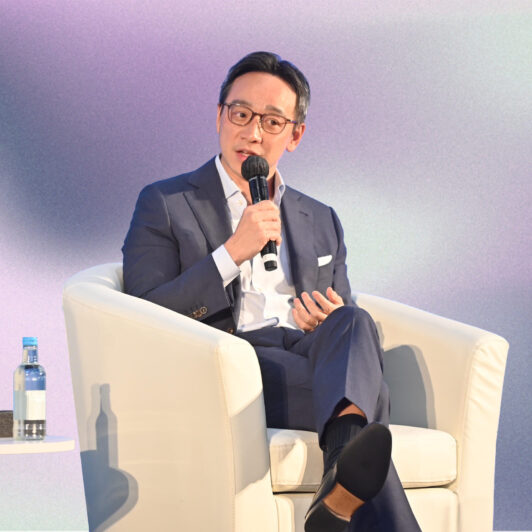This edition of Office Hours, a series highlighting the company’s senior leaders, showcases Grace Gu.
Grace joined Two Sigma in 2020 to build its “scientific discretionary” investing business, which melds systematic and more traditional discretionary approaches. Her background includes founding her own global macro investment firm and holding senior portfolio management roles at Graham Capital Management and BlackRock.
She began her career as a quantitative researcher and portfolio manager at Goldman Sachs on its flagship Global Alpha Fund. Grace holds both a B.S. in Electrical Engineering and an M.S. in Financial Mathematics from Stanford University.
Read on to learn about Grace’s unique career path, how she sees systematic and discretionary approaches potentially complementing each other, and the essential personal qualities she believes help define a successful investment manager.
What led you to your current role, and what are your main responsibilities at Two Sigma?
My high school years coincided with the 1998-2001 tech bubble. As someone with a strong interest in science and math, I was drawn to technology and its potential to transform the world while providing a good career path. But before I even started college at Stanford, the tech boom had become the tech bust.
Instead, an “accidental” internship at Goldman Sachs led me to discover finance—and to join the world of quant investing after graduation.
Over the next 12 years, I switched the focus of my career from systematic investing to discretionary investing. By the time I arrived at Two Sigma in 2020, I’d dealt first-hand with the relative strengths and weaknesses of systematic investing in macro, and I had experimented with and refined a discretionary approach that takes advantage of scientific methods to aid sound human decision-making.
At Two Sigma, my main responsibilities are to build on this approach by developing and managing what we call “scientific discretionary” macro investment strategies. When we began this initiative in 2021, it was actually the company’s first move into discretionary investing after 20 years of successful operation as a purely systematic manager.
At a high level, how can a systematic approach to investing inform a discretionary one, and vice versa?
Systematic and discretionary approaches to investing can inform and strengthen one another in meaningful ways.
Systematic investing brings rigor and discipline by leveraging data, quantitative methods, and robust portfolio optimizations. Discretionary investors benefit from these data and tools to improve the consistency and objectivity of their decision-making, optimizing risk-reward trade-offs, and reducing behavioral biases.
For example, data can be very expensive, and discretionary managers often find cost unjustifiable since they tend to use data episodically. At Two Sigma, however, the discretionary team has access to a huge number of datasets at essentially no additional cost. They’re “free” in the sense that our discretionary teams use the data so differently that we don’t compete with or reduce the edge of our systematic-focused colleagues. Standing on the shoulders of a systematic investment giant made jump-starting a new discretionary business a lot easier.
Each method’s strengths may help mitigate the other’s limitations, and make the overall platform more resilient and robust.
Conversely, discretionary investing offers creativity, contextual understanding, and flexibility—especially valuable when interpreting sudden policy shifts or market events that systematic models might overlook. Our discretionary process can take differentiated or even opposing views versus our systematic process in certain situations, bringing low or even negative return correlations to a broader portfolio, potentially delivering strong diversification benefits. Discretionary insights can also generate new hypotheses and datasets that feed back into systematic research, as well as guide selective overrides or hedging when systematic models face blind spots.
Ultimately, practicing both systematic and discretionary disciplines rigorously may generate “gains from trade,” potentially enhancing alpha generation, risk control, and adaptability across different market environments. Each method’s strengths may help mitigate the other’s limitations, and make the overall platform more resilient and robust.
What do you see as being the most important qualities for someone aspiring to be a successful investment manager?
My personal view is that the most important qualities for someone seeking a career in investment management go beyond technical skills alone—they’re really about the kind of person you are. These qualities become especially prominent if one chooses to pursue discretionary investing, where, unlike systematic investing, decision-making is not constrained by rigorous quantitative frameworks.
The most important qualities for someone seeking a career in investment management go beyond technical skills alone—they’re really about the kind of person you are.
First, I believe you need exceptional insight, which is a mix of strong analytical thinking and genuine creativity. The greatest investors I’ve observed not only analyze data well, but also think outside the box to spot opportunities others might miss.
Second, having guts is essential. Risk-taking often means going against the crowd and feeling comfortable with the possibility of being wrong often. The best investors aren’t afraid to make unconventional calls when their research backs it up.
Third, objectivity is key. We all have biases, but objective investors are able to recognize them, learn from mistakes, and adjust their strategies accordingly. This self-awareness and willingness to adapt really sets successful managers apart.
Finally, I believe discipline is what ties everything together. Insights and bold decisions only pay off if investment managers stick to their strategy over time, especially during tough periods. Discipline helps them execute consistently and “stay in the game,” allowing skill to dominate luck in the long run.
What do you believe are the advantages and challenges of working in a highly collaborative environment versus a more individualistic one?
Collaboration is a part of Two Sigma’s DNA, a key pillar of our sustainable edge, in my view. As the saying goes, “If you want to go fast, go alone. If you want to go far, go together.”
Two Sigma’s platform is an ecosystem where mathematicians, scientists, and engineers pursue research they feel passionate about, while collectively adding to the investment capabilities of the firm.
We carefully design incentives to reward both individual contributions and collaboration, and we work hard to attract and retain talented people who will respond well in such an environment. Working together, colleagues challenge each other’s assumptions, help reduce individual biases, and come up with better solutions in the face of complex market dynamics.
While a more individualistic approach can have certain advantages (e.g., potentially faster decision-making and short-term efficiency), we feel that our collaborative culture provides a strong foundation to build valuable intellectual property over the long run and create a sustainable competitive advantage.
What’s been capturing your interest outside of work lately?
The rapid adoption of AI into all aspects of the global economy has been capturing a lot of my attention recently. Ever since the release of ChatGPT in November 2022, concerns have intensified about the potential impact of AI on employment, especially entry-level, white-collar jobs. I expect these concerns to deepen in the coming years, as AI’s abilities grow.
At the same time, AI is already delivering economic benefits, especially for companies in knowledge-intensive industries, such as finance, technology, healthcare, and other professional services. These benefits may increase and broaden, too, as productivity upswing potentially lifts growth and eases some inflation pressures.
The rapid pace of AI innovation raises many critical questions for individuals, companies, and societies:
- How do we equip the younger generation educationally, so they can adapt to rapid AI disruptions in the workforce?
- What responsibilities do corporate management teams have to their stakeholders as AI disrupts the workplace?
- And how can policymakers across the globe help distribute such gains more equitably, while mitigating its downsides?
We don’t have all the answers yet, but the way society approaches these challenges and opportunities will have far-reaching consequences for years to come.






